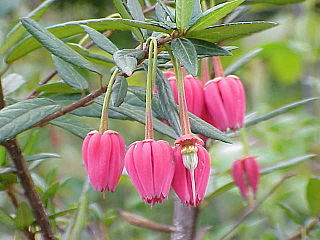
Lupinus, commonly known as lupin, lupine, or regionally bluebonnet etc., is a genus of flowering plants in the legume family Fabaceae. The genus includes over 199 species, with centers of diversity in North and South America. Smaller centers occur in North Africa and the Mediterranean. They are widely cultivated, both as a food source and as ornamental plants, although in the Nordic countries and New Zealand's South Island, introduced lupins are viewed as a severe environmental threat.

Elaeaocarpaceae is a family of flowering plants. The family contains approximately 615 species of trees and shrubs in 12 genera. The largest genera are Elaeocarpus, with about 350 species, and Sloanea, with about 120.

Polypodiaceae is a family of ferns. In the Pteridophyte Phylogeny Group classification of 2016, the family includes around 65 genera and an estimated 1,650 species and is placed in the order Polypodiales, suborder Polypodiineae. A broader circumscription has also been used, in which the family includes other families kept separate in PPG I. Nearly all species are epiphytes, but some are terrestrial.
SM-1 was a 2-megawatt nuclear reactor developed by the American Locomotive Company (ALCO) and the United States Atomic Energy Commission (AEC) as part of the US Army Nuclear Power Program (ANPP) in the mid-1950s. The compact "package" reactor was designed to produce electricity and generate heat for remote military facilities. The first, the SM-1, served as the Army's primary training facility to train reactor operations personnel from all three services. In 1954, the Department of Defense placed the US Army in charge of all military nuclear power plants except those used for propulsion by the US Navy. The Army's Chief of Engineers established the US Army Engineer Reactors Group in April 1954, and decided to construct the SM-1 facility at the Corps of Engineers headquarters at Fort Belvoir, Virginia, about 18 miles south of Washington, D.C. About 800 personnel were trained on the SM-1 during its operational life, from 1957 to 1973. The power plant was shut down in March 1973, and is monitored within a "restricted access" section of the post. Inspectors enter the shut-down operations control room every decade or so. The Army plans to start demolition in 2020.

Woodwardia is a genus of ferns in the family Blechnaceae, in the suborder Aspleniineae of the order Polypodiales. Species are known as chain ferns. The genus is native to warm temperate and subtropical regions of the Northern Hemisphere. They are large ferns, with fronds growing to 50–300 cm long depending on the species. The fossil record of the genus extends to the Paleocene.

Meiogyne is a genus of flowering plants with about 28 species belonging to the family Annonaceae. It is native from southwestern India and Indochina to Australia, including Fiji and New Caledonia.
Brassiantha hedraiantheroides is a species of Australian understory shrubs or small trees, constituting part of the plant family Celastraceae. In 2012 botanist Andrew J. Ford formally scientifically named and described them as the first recognised Australian species of the genus Brassiantha. Previously several publications provided informal scientific descriptions of this species under the provisional names "Hedraianthera sp. Mossman Qld Herbarium" or "Hedraianthera sp. Mossman".

Pterozonium is a genus of ferns in the subfamily Pteridoideae of the family Pteridaceae. Species are mainly found in north-western South America, as well as Costa Rica.

Sphyrospermum is a genus of flowering plants belonging to the family Ericaceae.
Periclesia is a monotypic genus of flowering plants belonging to the family Ericaceae. It only contains one known species, Periclesia flexuosaA.C.Sm. It is also with the Vaccinioideae subfamily and the Vaccinieae tribe.
Themistoclesia is a genus of flowering plants belonging to the family Ericaceae.
Bejaria is a genus of flowering plants belonging to the family Ericaceae.
Cheiloclinium is a genus of flowering plants belonging to the family Celastraceae.
Elachyptera is a genus of flowering plants belonging to the family Celastraceae.
Hedstromia is a monotypic genus of flowering plants belonging to the family Rubiaceae. It only contains one species, Hedstromia latifoliaA.C.Sm.

Demosthenesia is a genus of flowering plants belonging to the family Ericaceae.
Diogenesia is a genus of flowering plants belonging to the family Ericaceae.
Orthaea is a genus of flowering plants belonging to the family Ericaceae.

Plutarchia is a genus of flowering plants belonging to the family Ericaceae.
Zanthoxyloideae is a subfamily of the family Rutaceae.








